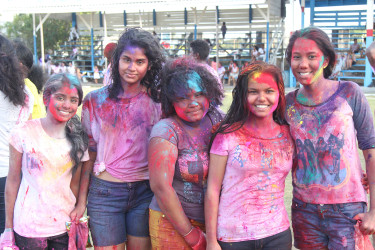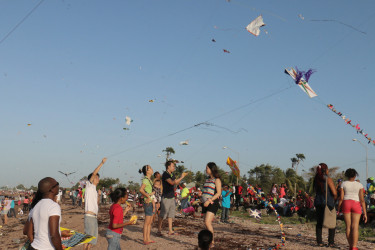Guyana has just witnessed one of the rare wonders of its composition as a multicultural society. Today is Easter Sunday, the high day of the Christian celebration of the Easter festival. It is the zenith of the Christian festival, but actually the end of two religious weeks that were observed almost simultaneously. It saw the coincidence of two major festivals belonging to two different major religions of Guyana. It was the Holy Week of the Christians and the week of Holi for the Hindus, containing two important holidays – Phagwah Day on Wednesday and Good Friday just two days after.
 The study of cultural festivals continues to be of great interest, and particularly so in a multicultural society like Guyana where the festivals of three dominant religions co-exist, occasionally being celebrated in proximity to each other. Christianity, Hinduism and Islam also happen to be the largest, most dominant religions in the world and their practice in Guyana will always offer significant details of comparison and parallel. These come with the cultural practices that arise from the religions and in particular their feasts and festivals which also serve as national cultural festivals.
The study of cultural festivals continues to be of great interest, and particularly so in a multicultural society like Guyana where the festivals of three dominant religions co-exist, occasionally being celebrated in proximity to each other. Christianity, Hinduism and Islam also happen to be the largest, most dominant religions in the world and their practice in Guyana will always offer significant details of comparison and parallel. These come with the cultural practices that arise from the religions and in particular their feasts and festivals which also serve as national cultural festivals.
The coincidence of Phagwah and Easter mere days apart in Guyana provides another opportunity to see the great similarities. These may be found across all of them – the Christian, the Hindu and the Muslim. It is always of interest to revisit them and highlight new observances, with the telling reminder of just how close the differing peoples are. Ironically, wars based on these very religions have been very bitter through history, still with resonances today. They are at the source of the coolness between India and Pakistan, violent unease inside of countries, and past ‘Fulla Man’ hostilities in Guyana itself.

The week just ended contained the high point, the climax of Phagwah, also known as Holi. There was the national holiday with its characteristic celebrations and sacred rituals. But it was also the end of a long period leading up to that day for those engaged in the religious practice. It culminated in a festival day which is religious, but also traditional, calendar, cultural and popular. It is observed in accordance with the main characteristics of a festival of its type – that is, its demonstration of sacred Hindu rites, but also popular practices and revelry which all arise from its peculiar mythology, literature and beliefs.
Similarly, the Easter weekend contains three days – two sacred and one festive; Good Friday, Easter Sunday and Easter Monday. But that weekend is the culmination of Holy Week, which preceded it, and also the end of a period religiously observed by those engaged in the practice. It peaked in the festival which is, of course, a religious one, but which is as well traditional, cultural, calendar and popular. Easter, too, is characterised by demonstrations of holy rituals, but also more public demonstrations which are based on religious beliefs expressed in its mythology and literature, and related to popular traditions and revelry.
Celebrants of both Phagwah and Easter have similar ways of expressing their different spiritual beliefs, and these ways are central to the making of the festivals. Significantly, these factors were recognised by a current project embarked upon by the UNASUR grouping of South American nations – the Expreso Sur video project. A number of countries including Guyana, Surinam, Venezuela and Colombia are involved in making a film of a prominent national festival. Each festival is studied and demonstrates the ways of expression peculiar to it. The study of Easter and Phagwah easily show these similar ways.

Easter is a calendar festival because it is tied to the sequence of dates fixed in the calendar year and based on ancient origins. For example, Easter is not only what is happening now, it is dated back to much earlier events in the year. According to Christian beliefs and practice, Good Friday comes 40 days after Ash Wednesday and both are fixed in the annual calendar, but never occur on the same date each year. In 2016, Good Friday was March 25, but it was on a different date last year, and it will not be the same next year. Ash Wednesday is the start of Lent and the Lenten period represents the 40 days and nights that Jesus spent “in the wilderness” preparing himself for Good Friday and the crucifixion.
Where Phagwah is concerned, the period of Holi actually begins 40 days before the Phagwah festival. This is marked by the Planting of Holika on the specific day in the calendar, which is also fixed by ancient events, but does not fall on the same date each year. This is a religious rite symbolised by the planting of a castor oil tree. This same tree will be uprooted 40 days later to begin the sequence of events leading up to the “burning of Holika” the night before Phagwah. The 40-day period also begins on the birthday of the Hindu Goddess of Knowledge Sarswattie to whom devotions are dedicated as well. It also marks the beginning of spring, because Phagwah is also a spring festival, originally celebrated at spring time in North India.
Both of these observances and belief systems arise from literature and mythology. The Easter story is in the Holy Bible and is a complex one detailing the life and work of Jesus and all that occurred during Holy Week, the crucifixion, and the Resurrection on Easter Sunday. Several myths have arisen around that story and its significance to the point where they are also the source of many customs, traditions and superstitions, which have gone over from the religious into the secular.
The main and basic plot is that Christ (Jesus) came to earth for a purpose – to actually save mankind, usher in a new dispensation of grace – offer the possibility for all mankind to access eternal salvation through the intervention of Christ. It is a message of the triumph of good over evil, a message of hope for all and the rewards of faith and devotion to God.
There is very little difference in the Hindu Phagwah where the general message is the same – the triumph of good over evil and the rewards for faith and devotion to God. In the story of Prince Prahalad’s triumph over his father King Haranyakashipu, the boy was prepared to sacrifice himself in standing behind his faith in the true god while defying his father who had set himself up as the (false) god. Prahalad was rewarded for his steadfast faith and the good example that he set for others.
Falsely set up by a boon from the gods which basically made him believe he could not die, the king felt like a god and ordered his kingdom to worship him. But his own son refused and the king was enraged by the ‘bad’ example the boy was setting and ordered him killed. After several attempts failed, the king’s sister Holika, who was immune to fire, took Prahalad into a raging bonfire so that he could be burnt up. But there was a miracle in which Holika’s immunity was revoked; she was burnt to ashes and the prince came out unscathed.
However, Phagwah is also a secular spring festival with agricultural origins. It celebrates spring and harvest, rebirth, regeneration and fertility. It is therefore a very youthful festival of much revelry and jollification. The throwing of water and of abeer, dyes and powder is symbolic of two things – the spreading and celebration of grain from the agriculture, of water and new growth, as well as the symbolic representation of the ashes of Holika. Similarly, the burning of Holika is a re-dramatisation of the great pyre into which she intended to destroy Prahalad but was instead, destroyed herself.
Many of the rites and practices arising from the story and from the spring celebration are based on belief. But at the same time they are popular manifestations, and although enacted in much revelry, are traditional symbols of what Hindus believe and popular shows of their scriptures.
Easter likewise has its many popular, public shows of Christian beliefs and symbolism. Even the popular custom of kite flying is said to be associated to symbols of the risen Christ shown in spectacular popular celebratory fashion. There was a popular custom in Guyana where everything shuts down on Good Friday in honour of the solemnity of the day; a custom observed even by those not religious.
Easter Monday has always been the festive day, when all popular revelry takes place. Popular culture has long since claimed Easter Monday, just as it has claimed Phagwah Day, especially after sun-down. There is a clear link in the case of both festivals between faith – sacred belief, and what happens in the popular culture when the religious festival becomes a secular popular one. These are normal features of cultural change.




